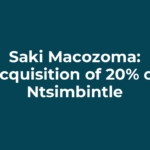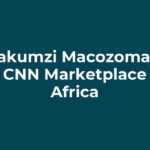Ntsimbintle’s long road to empowerment
Ntsimbintle’s story is one of dedication, determination and hard work that after seven years of labour is about to unlock shareholder value and create jobs. We are on the verge of establishing Tshipe é Ntle, a manganese mine that will benefit our children, their children and their children’s children. Ntsimbintle is proud that among its shareholders are those dedicated to social upliftment such as the Kgalagadi Rural Charitable Trust. This shareholder is already dispensing bursaries to the historically disadvantaged and will use Ntsimbintle’s future profits solely to help the people of the Northern Cape.
It started like this. In 2002 Government announced it wanted to broaden ownership of South Africa’s strategic resources, including manganese, which were then almost completely controlled by established big business. The dream of a broad-based Black Economic Empowerment (BBBEE) company that would become a significant presence in the manganese industry led to discussions with major manganese miners.
In 2003 nine black groups formed Ntsimbintle Mining (PTY) Ltd., a BBBEE company created specifically to pursue manganese opportunities. Safika Holdings (Pty) Ltd. and Nkonjane Economic Prospecting and Investments (Pty) Ltd. jointly led and financed the process and worked to bring charitable and social responsibility groups into the company as shareholders.
Later in 2003 Ntsimbintle joined forces with Samancor Manganese (Pty) Ltd. to apply for prospecting rights on Samancor-owned properties in the Kalahari manganese basin. In March 2004 the Department of Minerals and Energy (DME), now known as the Department of Mineral Resources (DMR) rejected the application and in April 2004 the government introduced the Mineral and Petroleum Resource Development Act (MPRDA) allocating rights as it deemed appropriate on alienated State land. Ntsimbintle negotiated a second deal with Samancor under which Ntsimbintle applied for prospecting rights in three areas. In 2004 Ntsimbintle was awarded two of the three applications but the agreement with Samancor lapsed because it hinged of obtaining rights for all three.
However, hard work was beginning to pay off, Ntsimbintle now held prospecting rights on two potentially lucrative properties. It took another two years before the formalities were complete and the company had the necessary documentation to allow it to start prospecting.
In the meantime Ntsimbintle shelved negotiations with other groups and embarked on a strategy of ‘go it alone’. In 2005 it applied for five additional sets of rights and extension of the rights it already owned.
2006 was a busy year. Ntsimbintle was finally allowed to start prospecting on its Mamatwan permit, an operation funded by Safika and Nkonjane. Midway through the year a third round of negotiations commenced with Samancor Manganese and Ntsimbintle also entered into discussions with interested groups elsewhere in the world to consider partnerships in manganese. These discussions led to a prospecting joint venture with London-based Pallinghurst Resources on Mamatwan and Wessels, two areas owned by Ntsimbintle. Pallinghurst is led by Brian Gilbertson, a former head of BHP Billiton. Ntsimbintle also worked closely with the Department of Mineral Resources to create an ideal structure for international cooperation.
In 2007 an agreement was reached with Samancor under which Ntsimbintle vended to Samancor certain portions of areas in which Ntsimbintle had prospecting rights. These were a relatively small portion of Ntsimbintle’s overall manganese prospecting right portfolio. In exchange Ntsimbintle gained nine per cent of Hotazel Manganese Mines. The transaction was subject to ministerial approval which was subsequently granted. The transaction with Samancor Manganese went unconditional on July1, 2009.
In June 2008 Ntsimbintle was granted additional prospecting rights in the Kalahari manganese basin – at Gloria and Wessels North. The company had applied for five additional areas.
The next step is to build the Tshipi é Ntle manganese mine on Ntsimbintle land in the Northern Cape. Funding for the mine’s development has been raised; Ntsimbintle is now in the process of fine-tuning financial arrangements in order to maximize shareholder value.
The DMR is processing the administration work involved with the issuing of the mining right. It is expected that Ntsimbintle will receive this documentation in November 2009. Once the mining right is issued Ntsimbintle is completely ready to start building. If it started work in November 2009, the mine would begin production in the first quarter of 2011. This timeframe is dependent on Transnet, the organization that has to provide rail capacity to transport our ore to the ports. Ntsimbintle is in negotiations with Transnet seeking an early date for the provision of that capacity.
Once this has been achieved a stand-alone mine will be developed which, based on initial feasibility studies could employ 390 people and indirectly benefit thousands more. The manganese that will be mined at Tshipi é Ntle is of high quality and can be extracted more cheaply than many of its competitors. Off take agreements are in place to export some of its production. When it reaches peak production – two years after it is commissioned – Tshipi é Ntle will be producing two million tons of manganese a year. It will be able to carry on doing so for at least the next 30 years.
Ntsimbintle is not only focusing on the new mine, it is continuing to prospect on other properties on which it has rights and early results are encouraging. The company is also continuing its efforts to pursue the consolidation of certain prospecting rights with a view to future mining projects.
It has been a long hard road but the shareholders of Ntsimbintle are on the verge of seeing their dreams realized. Value has been created, a new mine is now close to reality and future prospects are bright.

